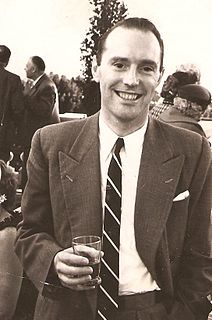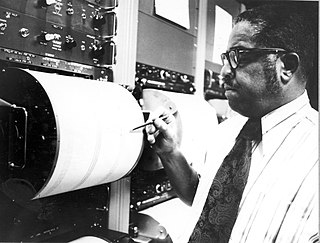Related Research Articles

Seismology is the scientific study of earthquakes and the propagation of elastic waves through the Earth or through other planet-like bodies. The field also includes studies of earthquake environmental effects such as tsunamis as well as diverse seismic sources such as volcanic, tectonic, glacial, fluvial, oceanic, atmospheric, and artificial processes such as explosions. A related field that uses geology to infer information regarding past earthquakes is paleoseismology. A recording of Earth motion as a function of time is called a seismogram. A seismologist is a scientist who does research in seismology.

Frank Press was an American geophysicist. He was an advisor to four U.S. presidents, and later served two consecutive terms as president of the U.S. National Academy of Sciences (1981–1993). He was the author of 160 scientific papers and co-author of the textbooks Earth and Understanding Earth.

Bruce Alan Bolt was an Australian-born American seismologist and a professor of earth and planetary science at the University of California, Berkeley. Professor Bolt was known as a pioneer of engineering seismology. He served for 15 years on the California Seismic Safety Commission leading public debate on earthquake safety in that state, and acted as a consultant on major projects throughout the world. As well, Bolt published a number of popular and technical books on seismology.

The 1970 Ancash earthquake occurred on 31 May off the coast of Peru in the Pacific Ocean at 15:23:29 local time. Combined with a resultant landslide, it is the most catastrophic natural disaster in the history of Peru. Due to the large amounts of snow and ice included in the landslide that caused an estimate of 66,794 to 70,000 casualties, it is also considered to be the world's deadliest avalanche.

Harry Fielding Reid was an American geophysicist. He was notable for his contributions to seismology, particularly his theory of elastic rebound that related faults to earthquakes.

The 1976 Guatemala earthquake struck on February 4 at 03:01:43 local time with a moment magnitude of 7.5. The shock was centered on the Motagua Fault, about 160 km northeast of Guatemala City at a depth of 5 kilometers (3.1 mi) near the town of Los Amates in the department of Izabal.
Clarence Roderic Allen was a geologist who studied seismology.

Lucile M. Jones is a seismologist and public voice for earthquake science and earthquake safety in California. One of the foremost and trusted public authorities on earthquakes, Jones is viewed by many in Southern California as the "seismologist-next-door," who is frequently called up on to provide information on recent earthquakes.
A supershear earthquake is an earthquake in which the propagation of the rupture along the fault surface occurs at speeds in excess of the seismic shear wave (S-wave) velocity. This causes an effect analogous to a sonic boom.
George W. Housner was a professor of earthquake engineering at the California Institute of Technology and National Medal of Science laureate.
Mary Lou Zoback is an American geophysicist who led the world stress map project of the International Lithosphere Program. Zoback is currently a member of the U.S. Nuclear Waste Technical Review Board.
Kerry E. Sieh is an American geologist and seismologist.

The Seismological Society of America (SSA) is an international scientific society devoted to the advancement of seismology and the understanding of earthquakes for the benefit of society. Founded in 1906, the society has members throughout the world representing seismologists and other geophysicists, geologists, engineers, insurers, and policy-makers in preparedness and safety.

Harry Bolton Seed was an educator, scholar, former Professor at the University of California, Berkeley. He was regarded as the founding father of geotechnical earthquake engineering.

James Freeman Gilbert was an American geophysicist, best known for his work with George E. Backus on inverting geophysical data, and also for his role in establishing an international network of long-period seismometers.

Nicholas Neocles Ambraseys FICE FREng was a Greek engineering seismologist. He was emeritus professor of Engineering Seismology and Senior Research Fellow at Imperial College London. For many years Ambraseys was considered as the leading figure and an authority in earthquake engineering and seismology in Europe.
Walter D. Mooney is a research seismologist and geophysicist at the United States Geological Survey (USGS), Menlo Park, California (1978–present). He was Chief of the USGS Branch of Seismology from 1994 to 1997.
Sankar Kumar Nath is an Indian geophysicist, seismologist and a senior professor at the Indian Institute of Technology Kharagpur. He is known for his geotomographical studies and is an elected fellow of the Indian National Academy of Engineering, Indian Geophysical Union and the National Academy of Sciences, India, The Council of Scientific and Industrial Research, the apex agency of the Government of India for scientific research, awarded him the Shanti Swarup Bhatnagar Prize for Science and Technology, one of the highest Indian science awards for his contributions to Earth, Atmosphere, Ocean and Planetary Sciences in 2002.
Christie D. Rowe is a Professor of Geology at McGill University. She holds a Canada Research Chair in Earthquake Geology and was awarded the 2017 Geological Association of Canada W. W. Hutchison Medal.

Waverly J. Person is an American seismologist. He started his professional career in the United States Army, during which time he was awarded both the Good Conduct Medal and Asiatic–Pacific Campaign Medal. In the early 1970s Person helped to established the National Earthquake Information Center.
References
- ↑ Fuis, G. S.; Haeusslerb, P J.; Atwater, B. F. (2014), "A tribute to George Plafker", Quaternary Science Reviews , Elsevier, 113: 3–7, doi:10.1016/j.quascirev.2014.11.010 CS1 maint: discouraged parameter (link)
- ↑ Seismological Society of America (May 11, 2017). "George Plafker wins top honor in seismology" (Press release). Eurekalert!.
- ↑ Geological Society of America (July 6, 2017). "Geological Society of America honors Excellence in Geoscience for 2017" (Press release). Eurekalert!.